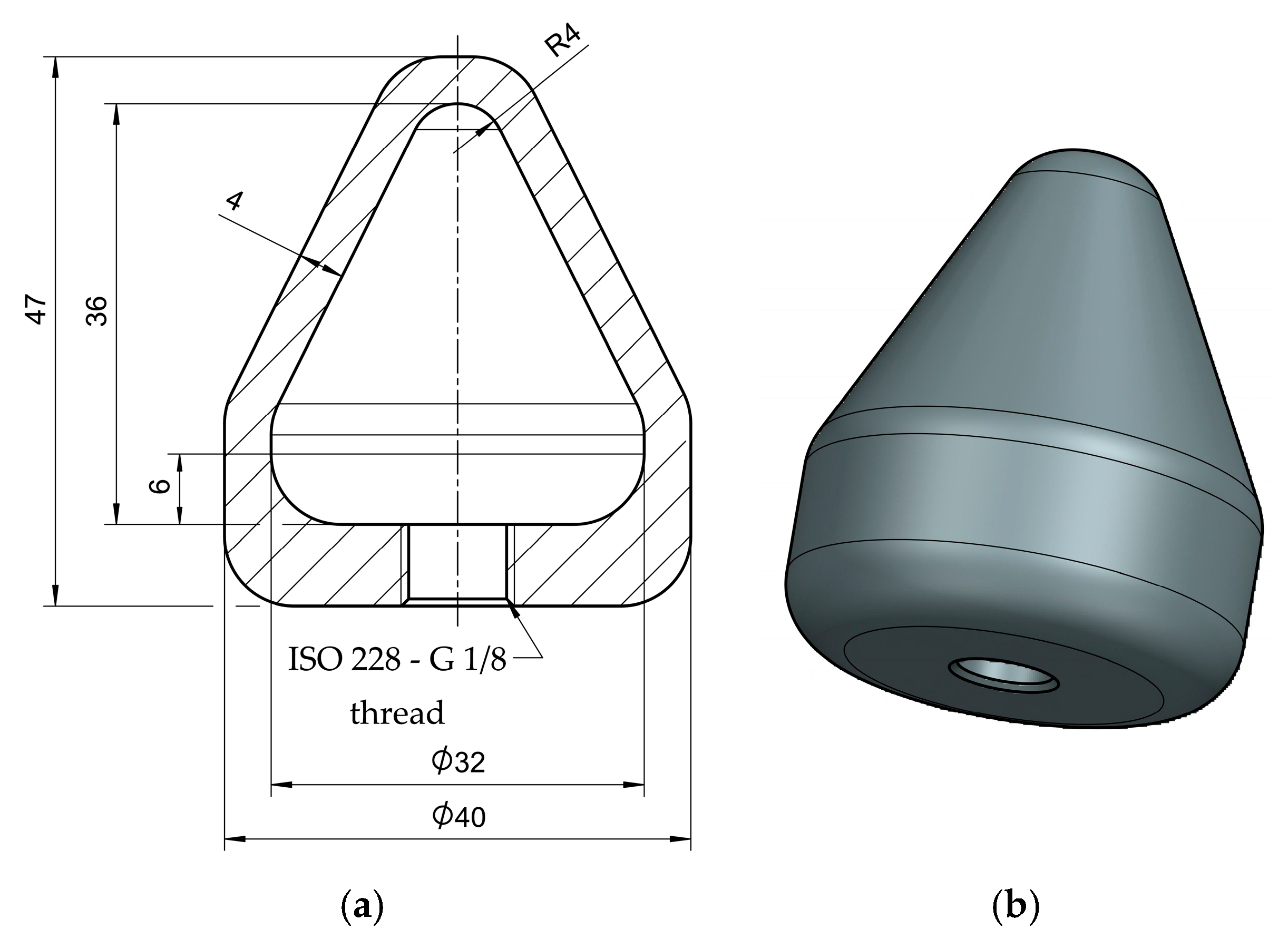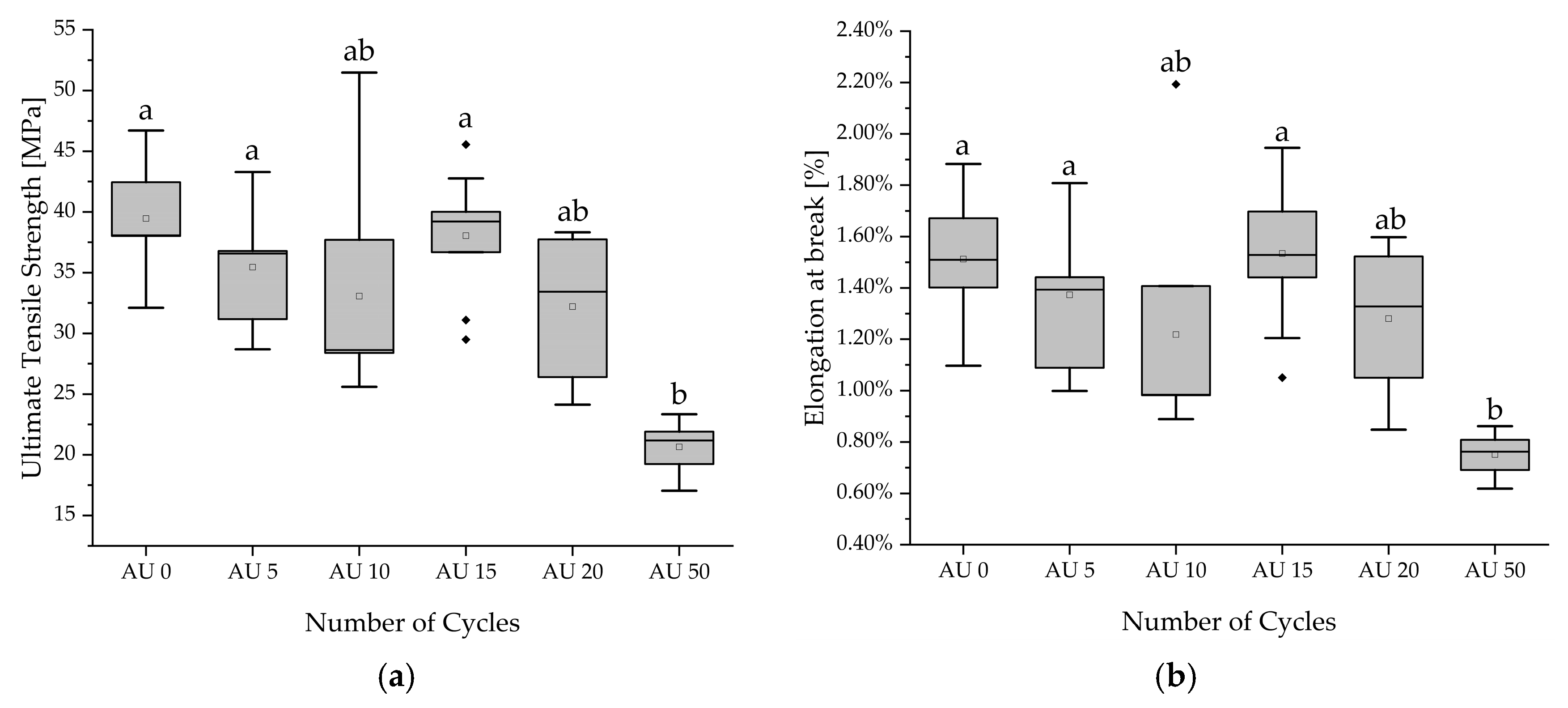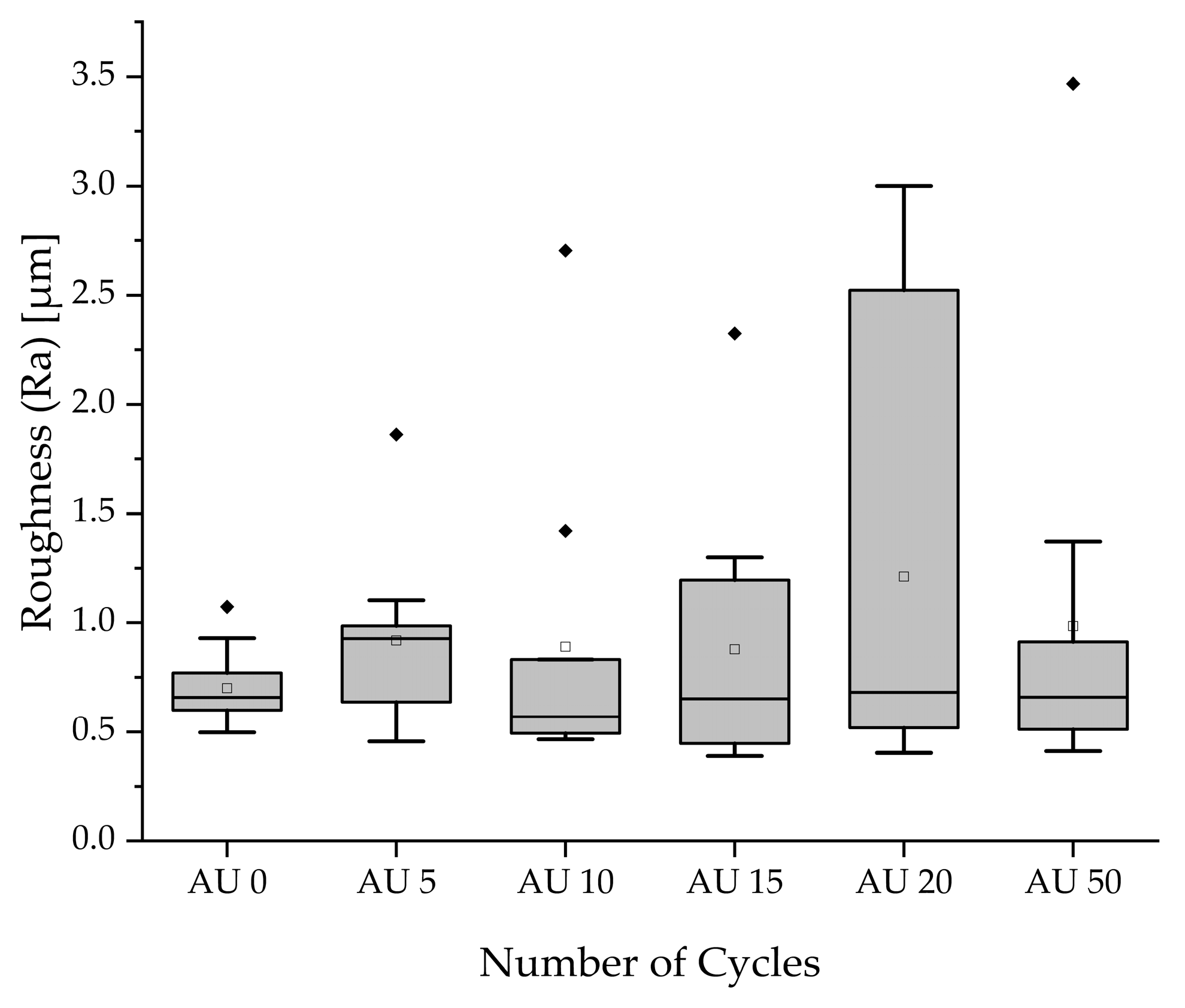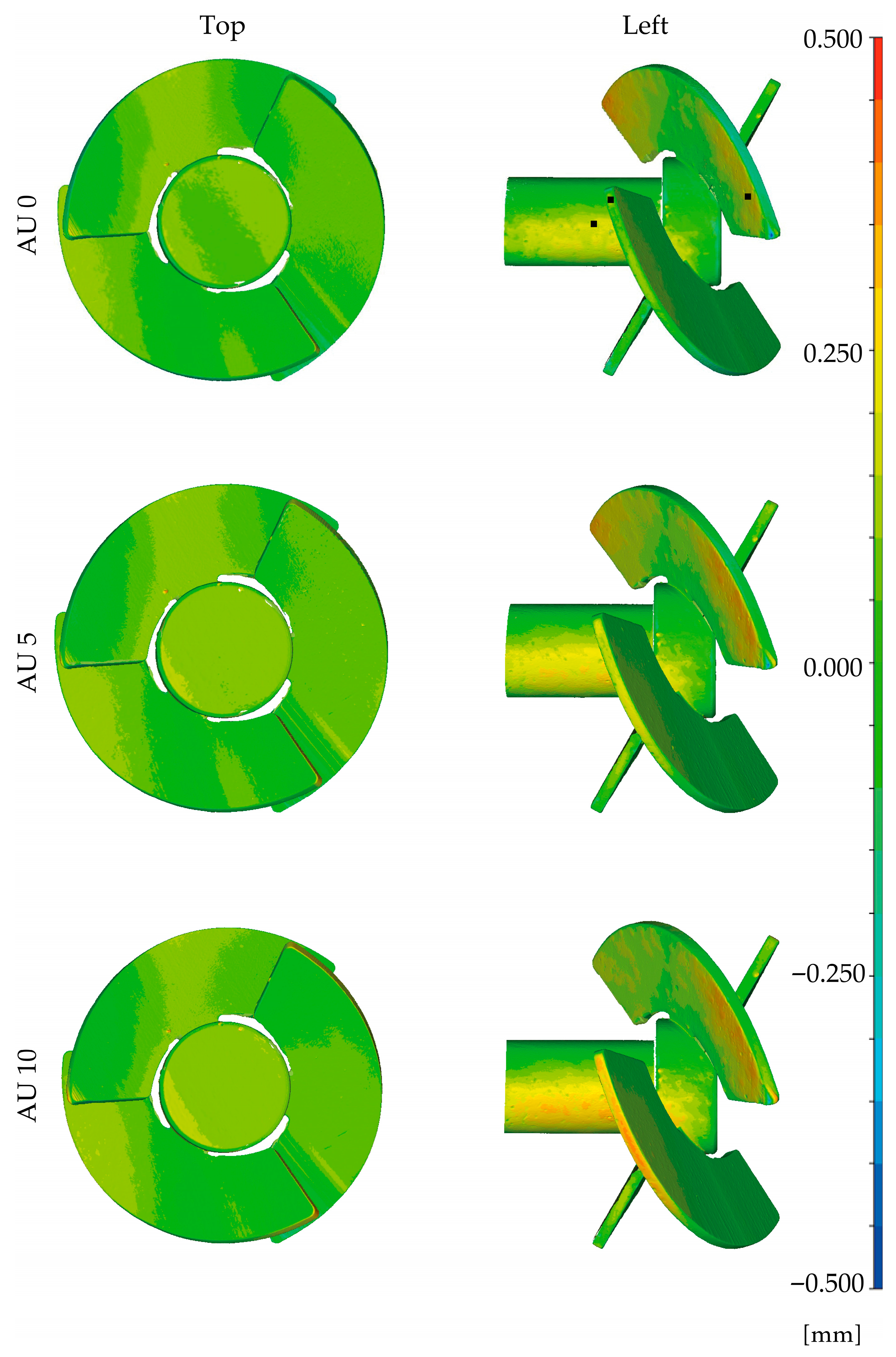Impact of Autoclaving on the Material Properties of Vat-Photopolymerization-Produced Components Intended for Bioprocess Engineering
Abstract
1. Introduction
2. Materials and Methods
2.1. Additive Manufacturing of Specimens
2.2. Autoclaving Method
2.3. Testing Methods
2.3.1. Tensile Testing
2.3.2. Charpy Impact Test
2.3.3. Roughness Testing
2.3.4. Surface Energy Determination
2.3.5. Scanning Electron Microscopy
2.3.6. Tightness Testing
2.3.7. Testing for Dimensional Changes
2.4. Statistics
3. Results
3.1. Tensile Testing
3.2. Charpy Impact Test
3.3. Roughness Testing
3.4. Surface Energy Determination
3.5. Scanning Electron Microscopy
3.6. Tightness Testing
3.7. Testing for Dimensional Changes
4. Discussion
5. Conclusions
- For mechanical properties like tensile strength, elongation at break, and Charpy impact, decreasing values were reported first for specimens treated by 50 autoclaving cycles. For specimens treated with up to 20 autoclaving cycles, no significant changes in mechanical properties occurred.
- For surface properties, we detected no change in the surface roughness and no change in surface energies. The hydrophilic surface remained for all cycles.
- The additive-manufactured specimens for the tightness test stayed tight for the 20 autoclaving cycles tested.
- Regarding the dimensional changes in the tested benchmark bodies, no process-relevant deviations across ten autoclaving cycles were reported.
Supplementary Materials
Author Contributions
Funding
Data Availability Statement
Conflicts of Interest
References
- Ngo, T.D.; Kashani, A.; Imbalzano, G.; Nguyen, K.T.; Hui, D. Additive manufacturing (3D printing): A review of materials, methods, applications and challenges. Compos. Part B Eng. 2018, 143, 172–196. [Google Scholar] [CrossRef]
- Zhang, J.; Hu, Q.; Wang, S.; Tao, J.; Gou, M. Digital Light Processing Based Three-dimensional Printing for Medical Applications. Int. J. Bioprint. 2020, 6, 242. [Google Scholar] [CrossRef]
- Krujatz, F.; Lode, A.; Seidel, J.; Bley, T.; Gelinsky, M.; Steingroewer, J. Additive Biotech-Chances, challenges, and recent applications of additive manufacturing technologies in biotechnology. New Biotechnol. 2017, 39, 222–231. [Google Scholar] [CrossRef]
- Achleitner, L.; Winter, M.; Satzer, P. 3D printed autoclavable biocompatible biodegradable bioreactor vessels with integrated sparger made from poly-lactic acid. J. Biotechnol. 2024, 391, 33–39. [Google Scholar] [CrossRef]
- Coakley, M.; Hurt, D.E. 3D Printing in the Laboratory: Maximize Time and Funds with Customized and Open-Source Labware. J. Lab. Autom. 2016, 21, 489–495. [Google Scholar] [CrossRef] [PubMed]
- Seidel, S.; Mozaffari, F.; Maschke, R.W.; Kraume, M.; Eibl-Schindler, R.; Eibl, D. Automated Shape and Process Parameter Optimization for Scaling Up Geometrically Non-Similar Bioreactors. Processes 2023, 11, 2703. [Google Scholar] [CrossRef]
- Soerjawinata, W.; Kockler, I.; Wommer, L.; Frank, R.; Schüffler, A.; Schirmeister, T.; Ulber, R.; Kampeis, P. Novel bioreactor internals for the cultivation of spore-forming fungi in pellet form. Eng. Life Sci. 2022, 22, 474–483. [Google Scholar] [CrossRef]
- Scherer, K.; Huwer, A.; Ulber, R.; Wahl, M. Optimizing Luminous Transmittance of a Three-Dimensional-Printed Fixed Bed Photobioreactor. 3D Print. Addit. Manuf. 2022, 11, 467–475. [Google Scholar] [CrossRef]
- Scherer, K.; Soerjawinata, W.; Schaefer, S.; Kockler, I.; Ulber, R.; Lakatos, M.; Bröckel, U.; Kampeis, P.; Wahl, M. Influence of wettability and surface design on the adhesion of terrestrial cyanobacteria to additive manufactured biocarriers. Bioprocess Biosyst. Eng. 2022, 45, 931–941. [Google Scholar] [CrossRef]
- Told, R.; Ujfalusi, Z.; Pentek, A.; Kerenyi, M.; Banfai, K.; Vizi, A.; Szabo, P.; Melegh, S.; Bovari-Biri, J.; Pongracz, J.E.; et al. A state-of-the-art guide to the sterilization of thermoplastic polymers and resin materials used in the additive manufacturing of medical devices. Mater. Des. 2022, 223, 111119. [Google Scholar] [CrossRef]
- Pop, S.I.; Dudescu, M.; Mihali, S.G.; Păcurar, M.; Bratu, D.C. Effects of Disinfection and Steam Sterilization on the Mechanical Properties of 3D SLA- and DLP-Printed Surgical Guides for Orthodontic Implant Placement. Polymers 2022, 14, 2107. [Google Scholar] [CrossRef]
- Valls-Esteve, A.; Lustig-Gainza, P.; Adell-Gomez, N.; Tejo-Otero, A.; Englí-Rueda, M.; Julian-Alvarez, E.; Navarro-Sureda, O.; Fenollosa-Artés, F.; Rubio-Palau, J.; Krauel, L.; et al. A state-of-the-art guide about the effects of sterilization processes on 3D-printed materials for surgical planning and medical applications: A comparative study. Int. J. Bioprint. 2023, 9, 756. [Google Scholar] [CrossRef] [PubMed]
- Rynio, P.; Galant, K.; Wójcik, Ł.; Grygorcewicz, B.; Kazimierczak, A.; Falkowski, A.; Gutowski, P.; Dołęgowska, B.; Kawa, M. Effects of Sterilization Methods on Different 3D Printable Materials for Templates of Physician-Modified Aortic Stent Grafts Used in Vascular Surgery-A Preliminary Study. Int. J. Mol. Sci. 2022, 23, 3539. [Google Scholar] [CrossRef] [PubMed]
- DIN EN ISO/ASTM 52900:2022-03; Additive Fertigung-Grundlagen-Terminologie. Beuth Verlag: Berlin, Germany, 2022. (In German)
- Marei, H.F.; Alshaia, A.; Alarifi, S.; Almasoud, N.; Abdelhady, A. Effect of Steam Heat Sterilization on the Accuracy of 3D Printed Surgical Guides. Implant Dent. 2019, 28, 372–377. [Google Scholar] [CrossRef] [PubMed]
- Sharma, N.; Cao, S.; Msallem, B.; Kunz, C.; Brantner, P.; Honigmann, P.; Thieringer, F.M. Effects of Steam Sterilization on 3D Printed Biocompatible Resin Materials for Surgical Guides-An Accuracy Assessment Study. J. Clin. Med. 2020, 9, 1506. [Google Scholar] [CrossRef]
- Keßler, A.; Dosch, M.; Reymus, M.; Folwaczny, M. Influence of 3D-printing method, resin material, and sterilization on the accuracy of virtually designed surgical implant guides. J. Prosthet. Dent. 2022, 128, 196–204. [Google Scholar] [CrossRef]
- David, S.; Hüfner, M.; Rauch, N.; Kerberger, R.; Drescher, D.; Brunello, G.; Becker, K. Impact of Autoclaving on the Dimensional Stability of 3D-Printed Guides for Orthodontic Mini-Implant Insertion—An In Vitro Study. Clin. Exp. Dent. Res. 2025, 11, e70111. [Google Scholar] [CrossRef]
- Gordeev, E.G.; Galushko, A.S.; Ananikov, V.P. Improvement of quality of 3D printed objects by elimination of microscopic structural defects in fused deposition modeling. PLoS ONE 2018, 13, e0198370. [Google Scholar] [CrossRef]
- Suder, J.; Mlotek, J.; Panec, A.; Fojtík, F. Design of Printing Parameter Settings Methodology for FFF Printing of Waterproof Samples from a Flexible Material. Acta Mech. Slov. 2023, 27, 58–64. [Google Scholar] [CrossRef]
- Zimmermann, P.; Schammel, C.; Nagel, J. Additive Manufacturing of Watertight ABS Parts and Its Use for Chemical Metal Plating. Macro Mater. Eng. 2024, 310, 2400367. [Google Scholar] [CrossRef]
- Jo, K.-H.; Jeong, Y.-S.; Lee, J.-H.; Lee, S.-H. A study of post-processing methods for improving the tightness of a part fabricated by fused deposition modeling. Int. J. Precis. Eng. Manuf. 2016, 17, 1541–1546. [Google Scholar] [CrossRef]
- AL-Hasni, S.; Santori, G. 3D printing of vacuum and pressure tight polymer vessels for thermally driven chillers and heat pumps. Vacuum 2020, 171, 109017. [Google Scholar] [CrossRef]
- Andisetiawan, A.; Alkindi, T.; Atatreh, S.; Alhammadi, A.; Fetyan, A.; Bamgbopa, M.O.; Susantyoko, R.A. Stereolithography 3D printing for vanadium redox flow battery: Electrolyte compatibility and watertightness of 3D-printed parts. Next Mater. 2025, 6, 100317. [Google Scholar] [CrossRef]
- Gensler, M.; Leikeim, A.; Möllmann, M.; Komma, M.; Heid, S.; Müller, C.; Boccaccini, A.R.; Salehi, S.; Groeber-Becker, F.; Hansmann, J. 3D printing of bioreactors in tissue engineering: A generalised approach. PLoS ONE 2020, 15, e0242615. [Google Scholar] [CrossRef]
- Li, P.; Fernandez, P.K.; Spintzyk, S.; Schmidt, F.; Yassine, J.; Beuer, F.; Unkovskiy, A. Effects of layer thickness and build angle on the microbial adhesion of denture base polymers manufactured by digital light processing. J. Prosthodont. Res. 2023, 67, 562–567. [Google Scholar] [CrossRef]
- Zhang, Q.; Yu, Z.; Jin, S.; Liu, C.; Li, Y.; Guo, D.; Hu, M.; Ruan, R.; Liu, Y. Role of surface roughness in the algal short-term cell adhesion and long-term biofilm cultivation under dynamic flow condition. Algal Res. 2020, 46, 101787. [Google Scholar] [CrossRef]
- Sekar, R.; Venugopalan, V.P.; Satpathy, K.K.; Nair, K.; Rao, V. Laboratory studies on adhesion of microalgae to hard substrates. Hydrobiologia 2004, 512, 109–116. [Google Scholar] [CrossRef]
- Lee, W.-J.; Jo, Y.-H.; Yilmaz, B.; Yoon, H.-I. Effect of build angle, resin layer thickness and viscosity on the surface properties and microbial adhesion of denture bases manufactured using digital light processing. J. Dent. 2023, 137, 104608. [Google Scholar] [CrossRef] [PubMed]
- Kirschner, A.; David, S.; Brunello, G.; Keilig, L.; Drescher, D.; Bourauel, C.; Becker, K. Impact of Steam Autoclaving on the Mechanical Properties of 3D-Printed Resins Used for Insertion Guides in Orthodontics and Implant Dentistry. Appl. Sci. 2022, 12, 6195. [Google Scholar] [CrossRef]
- Linares-Alvelais, J.A.R.; Figueroa-Cavazos, J.O.; Chuck-Hernandez, C.; Siller, H.R.; Rodríguez, C.A.; Martínez-López, J.I. Hydrostatic High-Pressure Post-Processing of Specimens Fabricated by DLP, SLA, and FDM: An Alternative for the Sterilization of Polymer-Based Biomedical Devices. Materials 2018, 11, 2540. [Google Scholar] [CrossRef] [PubMed]
- Zhang, F.; Zhu, L.; Li, Z.; Wang, S.; Shi, J.; Tang, W.; Li, N.; Yang, J. The recent development of vat photopolymerization: A review. Addit. Manuf. 2021, 48, 102423. [Google Scholar] [CrossRef]
- Zhou, L.; Miller, J.; Vezza, J.; Mayster, M.; Raffay, M.; Justice, Q.; Al Tamimi, Z.; Hansotte, G.; Sunkara, L.D.; Bernat, J. Additive Manufacturing: A Comprehensive Review. Sensors 2024, 24, 2668. [Google Scholar] [CrossRef]
- Satzer, P.; Achleitner, L. 3D printing: Economical and supply chain independent single-use plasticware for cell culture. New Biotechnol. 2022, 69, 55–61. [Google Scholar] [CrossRef]
- Schneider, S.L.; Seidel, S.; Seefeldt, A.; Romang, M.; Kastl, S.; Gensel, J.; Neumeyer, T.; John, G.T.; Eibl, D. 3D Printed, Single-Use Bioreactor with Integrated Inline Sensors for Microbial and Mammalian Cell Cultivation—A Case Study. Processes 2023, 11, 3231. [Google Scholar] [CrossRef]
- Nexa3D. XiP Pro. Available online: https://nexa3d.com/3d-printers/resin-3d-printers/xip-pro/ (accessed on 16 September 2024).
- Nexa3D. Nexa3D xPeek147 Technical Data Sheet. Available online: https://nexa3d.com/materials/#explore (accessed on 25 February 2025).
- Henkel-Loctite. 3D Printing Workflow—Nexa3D-XiP Printer Settings—Resin: Loctite 3D IND147 HDT230 BK. Available online: https://www.loctiteam.com/wp-content/uploads/2022/11/W01055.pdf (accessed on 9 October 2025).
- DIN EN ISO 527-2:2012-06; Kunststoffe–Bestimmung der Zugeigenschaften–Teil 2: Prüfbedingungen für Form-und Extrusionsmassen. Beuth Verlag: Berlin, Germany, 2012. (In German)
- DIN EN ISO 527-1:2019-12; Kunststoffe-Bestimmung der Zugeigenschaften-Teil 1: Allgemeine Grundsätze. Beuth Verlag: Berlin, Germany, 2019. (In German)
- DIN EN ISO 179-1:2023-10; Kunststoffe-Bestimmung der Charpy-Schlageigenschaften Teil 1: Nicht Instrumentierte Schlagzähigkeitsprüfung. Beuth Verlag: Berlin, Germany, 2023. (In German)
- DIN EN ISO 19403-1:2022-09; Beschichtungsstoffe-Benetzbarkeit-Teil 1: Begriffe und Allgemeine Grundlagen. Beuth Verlag: Berlin, Germany, 2022. (In German)
- Owens, D.K.; Wendt, R.C. Estimation of the surface free energy of polymers. J. Appl. Polym. Sci. 1969, 13, 1741–1747. [Google Scholar] [CrossRef]
- Kaelble, D.H. Dispersion-Polar Surface Tension Properties of Organic Solids. J. Adhes. 1970, 2, 66–81. [Google Scholar] [CrossRef]
- DIN EN ISO 228-1:2003-05; Rohrgewinde für Nicht im Gewinde Dichtende Verbindungen—Teil 1: Maße, Toleranzen und Bezeichnung. Beuth Verlag: Berlin, Germany, 2003. (In German)
- R Core Team. R: A Language and Environment for Statistical Computing; R Foundation for Statistical Computing: Vienna, Austria, 2024. [Google Scholar]
- Hawkins, W.L. Polymer Degradation. In Polymer Degradation and Stabilization; Harwood, H.J., Hawkins, W.L., Eds.; Springer: Berlin/Heidelberg, Germany, 1984; pp. 3–34. ISBN 978-3-642-69378-6. [Google Scholar]
- Ceretti, D.V.A.; Edeleva, M.; Cardon, L.; D’hooge, D.R. Molecular Pathways for Polymer Degradation During Conventional Processing, Additive Manufacturing, and Mechanical Recycling. Molecules 2023, 28, 2344. [Google Scholar] [CrossRef]
- Alageel, O.; Alhijji, S.; Alsadon, O.; Alsarani, M.; Gomawi, A.A.; Alhotan, A. Trueness, Flexural Strength, and Surface Properties of Various Three-Dimensional (3D) Printed Interim Restorative Materials After Accelerated Aging. Polymers 2023, 15, 3040. [Google Scholar] [CrossRef]
- Yan, S.; Zhou, J.-L.; Zhang, R.-J.; Tan, F.-B. Evaluation of the influence of different build angles on the surface characteristics, accuracy, and dimensional stability of the complete denture base printed by digital light processing. Heliyon 2024, 10, e24095. [Google Scholar] [CrossRef]
- Mohanya, S.; Krishnanand; Nayak, A.; Taufik, M. Estimation of surface roughness for digital light processing based additively manufactured parts. Prog. Addit. Manuf. 2024, 10, 3779–3798. [Google Scholar] [CrossRef]
- Milde, J.; Peterka, J.; Jurina, F.; Dobrovszky, P.; Hrbal, J.; Pitek, P.; Martinovic, J. Influence of Selected Photopolymers on the Resulting Accuracy and Surface Roughness of the Component in Digital Light Processing Technology. In Proceedings of the 32nd International DAAAM Symposium 2021; Katalinic, B., Ed.; DAAAM International Vienna: Vienna, Austria, 2021; pp. 235–245. ISBN 9783902734334. [Google Scholar]
- Török, G.; Gombocz, P.; Bognár, E.; Nagy, P.; Dinya, E.; Kispélyi, B.; Hermann, P. Effects of disinfection and sterilization on the dimensional changes and mechanical properties of 3D printed surgical guides for implant therapy-pilot study. BMC Oral Health 2020, 20, 19. [Google Scholar] [CrossRef] [PubMed]
- Barros, A.C.; Gonçalves, A.L.; Simões, M. Microalgal/cyanobacterial biofilm formation on selected surfaces: The effects of surface physicochemical properties and culture media composition. J. Appl. Phycol. 2019, 31, 375–387. [Google Scholar] [CrossRef]
- Dong, Y.; Fan, S.-Q.; Shen, Y.; Yang, J.-X.; Yan, P.; Chen, Y.-P.; Li, J.; Guo, J.-S.; Duan, X.-M.; Fang, F.; et al. A Novel Bio-carrier Fabricated Using 3D Printing Technique for Wastewater Treatment. Sci. Rep. 2015, 5, 12400. [Google Scholar] [CrossRef] [PubMed]
- Cui, Y.; Yuan, W.; Cao, J. Effect of surface texturing on microalgal cell attachment to solid carriers. Int. J. Agric. Biol. Eng. 2013, 6, 44–54. [Google Scholar] [CrossRef]
- Kardel, K.; Carrano, A.L.; Blersch, D.M.; Kaur, M. Preliminary Development of 3D-Printed Custom Substrata for Benthic Algal Biofilms. 3D Print. Addit. Manuf. 2015, 2, 12–19. [Google Scholar] [CrossRef]
- Mahmud, M.S.; Urbay, J.E.; Delgadillo, A.; Fontes, D.; Zaman, S.; Garcia, X.O.N.; Lopez, A.; Joyce, S.N.; Roberson, D.A.; Michael, K.; et al. Thermo-mechanical deterioration and molecular degradation of 3D-printed methacrylate-based polymer in various chemical environments. Polym. Degrad. Stab. 2025, 242, 111633. [Google Scholar] [CrossRef]
- Bremer, M. Optical Measurement Under Space Conditions. Ph.D. Thesis, Unilu-University of Luxembourg, Luxembourg, 2022. [Google Scholar]
- Bernal, C.; de Agustina, B.; Marín, M.M.; Camacho, A.M. Performance Evaluation of Optical Scanner Based on blue LED Structured Light. Procedia Eng. 2013, 63, 591–598. [Google Scholar] [CrossRef]







| Autoclaving Cycles | |||||||
|---|---|---|---|---|---|---|---|
| 0 | 5 | 10 | 15 | 20 | 50 | ||
| Specimen Type | Tensile | × | × | × | × | × | × |
| Charpy * | × | × | × | × | × | × | |
| Tightness ** | × | × | × | × | × | ||
| Benchmark Bodies ** | × | × | × | ||||
| Group | Ultimate Tensile Strength [MPa] M ± SD | Bonferroni-Corrected Post Hoc Test **** p-Value | Elongation at Break [%] M ± SD | Bonferroni-Corrected Post Hoc Test **** p-Value |
|---|---|---|---|---|
| AU 0 | 39.47 ± 5.47 | 0.002 ** (AU0–AU50) | 1.51 ± 0.29 | 0.008 ** (AU0–AU50) |
| AU 5 | 35.46 ± 5.04 | 0.020 * (AU5–AU50) | 1.37 ± 0.29 | 0.024 * (AU5–AU50) |
| AU 10 | 33.07 ± 8.97 | 0.368 (AU10–AU50) | 1.22 ± 0.46 | - |
| AU 15 | 38.04 ± 5.11 | <0.001 *** (AU15–AU50) | 1.53 ± 0.28 | <0.001 *** (AU15–AU50) |
| AU 20 | 32.20 ± 5.93 | 0.287 (AU20–AU 50) | 1.28 ± 0.28 | 0.082 (AU20–AU50) |
| AU 50 | 20.65 ± 2.24 | - | 0.85 ± 0.05 | - |
| Group | Charpy Impact [kJ/m2] M ± SD | Bonferroni-Corrected Post Hoc Test **** |
|---|---|---|
| AU 0 | 3.60 ± 2.34 | <0.001 *** (AU0–AU50) |
| AU 5 | 2.06 ± 0.88 | 0.014 * (AU5–AU50) |
| AU 10 | 1.70 ± 0.60 | 0.192 (AU10–AU50) |
| AU 15 | 2.29 ± 1.02 | 0.005 ** (AU15–AU50) |
| AU 20 | 1.93 ± 1.37 | 0.157 (AU20–AU50) |
| AU 50 | 0.81 ± 0.18 | - |
| Group | Roughness Ra * [µm] M ± SD |
|---|---|
| AU 0 | 0.70 ± 0.18 |
| AU 5 | 0.92 ± 0.39 |
| AU 10 | 0.89 ± 0.70 |
| AU 15 | 0.88 ± 0.61 |
| AU 20 | 1.21 ± 1.03 |
| AU 50 | 0.98 ± 0.92 |
| Group | Surface Energy [mN/m] M ± SD | Contact Angle Water [°] M ± SD | Bonferroni-Corrected Post Hoc Test **** (p-Value) |
|---|---|---|---|
| AU 0 | 35.12 ± 1.09 | 78.3 ± 3.9 | - |
| AU 5 | 37.39 ± 3.38 | 67.8 ± 8.5 | 0.089 |
| AU 10 | 36.75 ± 2.05 | 70.0 ± 10.1 | 0.380 |
| AU 15 | 39.48 ± 3.08 | 66.0 ± 10.7 | 0.016 * |
| AU 20 | 42.25 ± 8.16 | 60.0 ± 14.3 | <0.001 *** |
| AU 50 | 39.75 ± 5.03 | 67.1 ± 14.4 | 0.073 |
Disclaimer/Publisher’s Note: The statements, opinions and data contained in all publications are solely those of the individual author(s) and contributor(s) and not of MDPI and/or the editor(s). MDPI and/or the editor(s) disclaim responsibility for any injury to people or property resulting from any ideas, methods, instructions or products referred to in the content. |
© 2025 by the authors. Licensee MDPI, Basel, Switzerland. This article is an open access article distributed under the terms and conditions of the Creative Commons Attribution (CC BY) license (https://creativecommons.org/licenses/by/4.0/).
Share and Cite
Hoffmann, L.; Gallace, B.; Herr, C.; Scherer, K.; Huwer, A.; Kampeis, P.; Ulber, R.; Wahl, M. Impact of Autoclaving on the Material Properties of Vat-Photopolymerization-Produced Components Intended for Bioprocess Engineering. Materials 2025, 18, 4720. https://doi.org/10.3390/ma18204720
Hoffmann L, Gallace B, Herr C, Scherer K, Huwer A, Kampeis P, Ulber R, Wahl M. Impact of Autoclaving on the Material Properties of Vat-Photopolymerization-Produced Components Intended for Bioprocess Engineering. Materials. 2025; 18(20):4720. https://doi.org/10.3390/ma18204720
Chicago/Turabian StyleHoffmann, Lauri, Bruno Gallace, Clara Herr, Kai Scherer, Adrian Huwer, Percy Kampeis, Roland Ulber, and Michael Wahl. 2025. "Impact of Autoclaving on the Material Properties of Vat-Photopolymerization-Produced Components Intended for Bioprocess Engineering" Materials 18, no. 20: 4720. https://doi.org/10.3390/ma18204720
APA StyleHoffmann, L., Gallace, B., Herr, C., Scherer, K., Huwer, A., Kampeis, P., Ulber, R., & Wahl, M. (2025). Impact of Autoclaving on the Material Properties of Vat-Photopolymerization-Produced Components Intended for Bioprocess Engineering. Materials, 18(20), 4720. https://doi.org/10.3390/ma18204720







